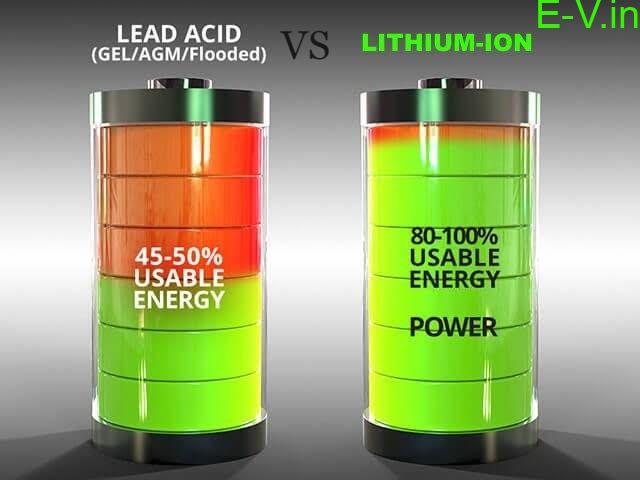
Lead-acid Versus Lithium-ion battery
In any electric vehicles, batteries play a major role and it is one of the most important components of an electric vehicle. We can see, electric vehicles are expensive due to batteries are costlier. One-third of the electric vehicle cost is of the battery. As lithium reserves are not available in India, most of the batteries or batteries cells are imported from other countries. In India, most commonly used batteries are lead-acid and lithium-ion batteries. So, let us discuss and compare these two battery types.
There are many types of batteries used in electric vehicles such as
- Lead-acid batteries
- Lithium-Ion batteries
- Nickel-Metal Hydride Batteries
- Ultracapacitors
- Lithium ferrous phosphate (LiFePO4)
But we will discuss most commonly used batteries in electric vehicles like lead-acid batteries and lithium-ion batteries.
What is the battery?
A battery is a device that consists of one or more electrochemical cells with external connections provided to power electrical devices like EV. It is used to power the propulsion system of battery-electric vehicles.
Different variety of energy storage options are available today such as pimped hydro, compressed air, capacitors, flywheels and rechargeable batteries.
So let us understand in detail the basics of lead-acid and lithium battery first.
Lead-acid batteries
This battery exists for more than a century. A fully charged state, a 2V electric potential exists between the cathode and anode.
During discharge, the electrons are passed externally through the load while internal chemical reactions at the interface of the electrolyte and the electrodes work to balance the charge equilibrium.
Lead-acid batteries can be divided into two different categories such a flooded and sealed/valve regulated (SLA or VRLA).
The Lithium-ion batteries
The lithium-ion batteries got popularity in the 1990s. They will have a basic mechanism that charged li-ion is shuttled back and forth between the cathode and the anode during discharge or when we charge it.
These batteries can be separated into two groups such as Lithium iron phosphate and metal oxides.
Now we have some basic ideas about lead-acid and lithium-ion batteries, let us now compare both the batteries.
Lead-acid Versus Lithium-ion battery
As lead-acid and Lithium-ion batteries are separated into different groups as mentioned above, we will take flooded lead-acid, VRLA lead-acid and Lithium-ion (LiNCM) for comparison.
| Flooded lead-acid | VRLA Lead-acid | Lithium-ion | |
| Energy Density (Wh/L) | 80 | 100 | 250 |
| Specific Energy (Wh/L) | 30 | 40 | 150 |
| Regular Maintenance | Yes | No | No |
| Initial Cost ($/kWh) | 65 | 120 | 600 |
| Cycle life | 1,200 @ 50% | 1,000 @ 50% DoD | 1,900 @ 80% DoD |
| State of Charge window | 50% | 50% | 80% |
| Temperature sensitivity | degrades above 25 degrees | degrades above 25 degrees | degrades above 45 degrees |
| Voltage Increments | 2V | 2V | 2V |
| Efficiency | 60% @ 1 hr rate | 60% @ 1 hr rate | 92% @ 1 hr rate |
(DoD-Depth of discharge)
Comparisons
Cycle life
Lithium-ion has significantly higher cycle life than lead-acid in discharge applications. The cycle life can be improved by limiting the DoD, discharge rate and temperature but lead-acid are generally much more sensitive to all these factors.
Rate Performance
Here a 100 Ah VRLA battery will only deliver 80 Ah if discharged over a four hour period and 100 Ah lithium-ion system will achieve over 98 Ah even during a 30-minute discharge. This condition is best suited for appliances where full discharge occurs in less than eight hours.
Cold weather performance
Both the batteries lose the capacity in cold weather conditions, but comparingly lithium-ion loses less capacity as the temperature drops into the -20 degree celsius range.
Environmental impact
Lead-acid batteries are very poor when compared to lithium-ion in regards to environmental friendliness. The process of making lead-acid requires more materials to achieve the desired capacity (storage) which impacts much on the environment during the mining process. It also pollutes the environment in large amounts which are dangerous to human health.
Safety
The cell rapidly heats and can emit electrolyte, flames and dangerous fumes. But in both, there are more chances of lithium-ion to get affected more as it is packed with a high amount of energy in a smaller volume.
( source- AllCell Technologies LLC)
For any promotions and advertisements on electricvehicles.in, please send an email to support@electricvehicles.inFor the latest electric vehicles news, follow electricvehicles.in on Twitter, Instagram, Facebook and subscribe to our YouTube Channels-English, Hindi & Telugu, & Kannada







